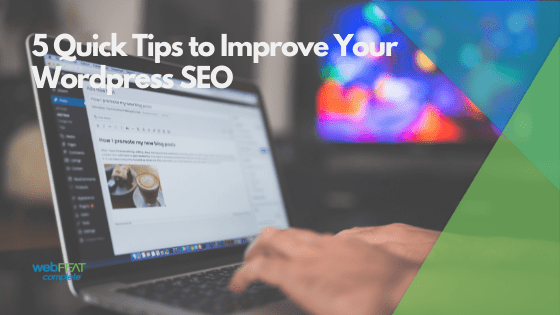SEO is an ongoing strategy, but if you are looking to quickly improve the appearance of your WordPress website, implementing these 5 tips can go a long way. At a minimum, making these improvements will help search engines index your website, provide you with performance data and keyword insights, drive more traffic to your site, and improve its speed and load times. The best part? Most of these tips can be implemented in a few minutes, if not seconds!
Ensure Your Website Is Being Indexed by Google and Other Search Engines
During the WordPress design process, it is a best practice to no-index your website so that users don’t stumble upon it within the search results while it’s in development. Often times, when it comes to launching the actual site, you get so excited and caught up in everything else that is involved and forget to index the website.
The solution is (typically) very simple.
Within your WP Admin, go to Settings → Reading
You’ll see a check box at the bottom of the page labeled “Discourage search engines from indexing this site”
Ensure this is unchecked when you are ready to take your site live.
Install Yoast SEO
Yoast is one of a few plugins we almost always recommend on WordPress sites. There are a few other options such as Rankmath and All in One SEO that work well too.
Here are a few reasons to utilize Yoast:
- It is compatible with the majority of WordPress themes
- It is updated frequently
- It saves you a ton of time updating page titles and meta descriptions
- Provides indexing settings so you can no-index single pages, posts, and category pages with a few clicks
- Provides on-page recommendations for improving keyword targeting
- Creates a sitemap.xml file for your website and gives you control of what is included in the file
- Adds Schema to your website
Setup Google Search Console for Your Website
Google Search Console is a powerful and free SEO tool every website owner should be utilizing. It is simple to setup too!
It provides you with insights about top performing pages and keywords, errors on your website like 404 pages or mobile indexing issues, the ability to submit a sitemap file to Google, and more.
Check out our post on Google Search Console’s Tools and Features post to learn more.
Create A WordPress Blog
Writing consistent articles on your site that are related to your products, services, and industry is one of the most important components to an effective SEO strategy.
Blog posts help you earn backlinks from other websites and users, build authority and credibility, drive traffic to your site, improve your ability to rank for keywords, and much more.
Learn about the types of content you should include in your blog.
Within your blog posts, you can link to more important, high conversion pages like service pages, specific products, and RFQ pages that can help improve your ability to drive sales and generate leads (like I just did above this sentence). Additionally, this strategy sends signals to Google about important pages on your site.
Optimize Website Images
The best practice for image optimization is to optimize them prior to uploading to your website. This will save you time in the long run.
A few benefits of image optimization include: improving website speed and performance, ADA compliance, your site’s ability to show up in Google search and Google images, and adhering to Google’s recent Page Experience Algorithm Update.
Here are a few tips for optimizing images:
- Use web based image formats. Most websites are typically using JPEG and PNG image formats, but there are formats meant for the web that lead to smaller files sizes and better web performance such as WebP.
- Don’t upload unnecessarily large files. If your image only needs to be 500px by 500px then only upload a file of that size. Overtime, having too many large images on your site will affect load times and will lead to a negative LCP (longest contentful paint).
- LCP is a metric browsers like Google use to determine how long it takes for content like images to load for web visitors.
- Add ALT tags to all images. This will help you show up in Google search and adhere to ADA compliance.
Looking for someone else to optimize your WordPress website for you? Our team of certified, SEO experts would be glad to provide you with a Free SEO Audit to help get you started.
“”





